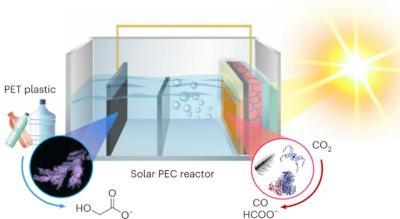Perovskite-Info weekly newsletter
Published: Tue, 01/17/23
The Perovskite-Info newsletter (January 17, 2023)
Cannot read this? View it online here
Perovskite absorbers enable solar-powered system that converts plastic and greenhouse gases into sustainable fuels
Researchers from the University of Cambridge have developed a system that can transform plastic waste and greenhouse gases into sustainable fuels and other valuable products – using energy from the Sun. The team states that this is the first time that a system that can convert two waste streams into two chemical products at the same time has been achieved in a solar-powered reactor.
The reactor converts carbon dioxide (CO2) and plastics into different products that are useful in a range of industries. In tests, CO2 was converted into syngas, a key building block for sustainable liquid fuels, and plastic bottles were converted into glycolic acid, which is widely used in the cosmetics industry. The system can easily be tuned to produce different products by changing the type of catalyst used in the reactor. The integrated reactor, which uses a light absorber based on perovskites, has two separate compartments: one for plastic, and one for greenhouse gases.
Researchers turn to facet engineering for more stable perovskite solar cells
Researchers at Switzerland's EPFL and Sungkyunkwan University in Korea have addressed the issue of perovskite solar cells' stability. They focused on the degradation of perovskite thin films, which can be damaged by exposure to moisture, heat, and light. The team looked at two specific crystal facets (the crystal's flat surface), characterized by a particular arrangement of atoms. The arrangement of atoms on these facets can affect the properties and behavior of the crystal, such as its stability and its response to external stimuli like moisture or heat.
The researchers looked at the (100) and (111) facets of perovskite crystals. The (100) facet is a plane that is perpendicular to a crystal's c-axis with its atoms arranged in a repeating pattern in the form of a square grid. In the (111) facet the atoms are arranged in a triangular grid. The study found that the (100) facet, which is most commonly found in perovskite thin films, is particularly prone to degradation as it can quickly transition to an unstable, inactive phase when exposed to moisture. In contrast, the (111) facet was found to much more stable and resistant to degradation.
Metalgrass LTD
9 Har Tsin St.
Kfar Sava Hasharon 4430809
ISRAEL
Unsubscribe | Change Subscriber Options






